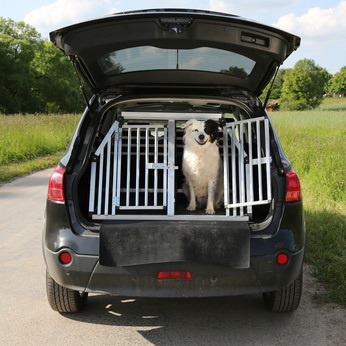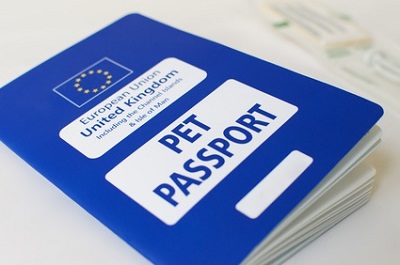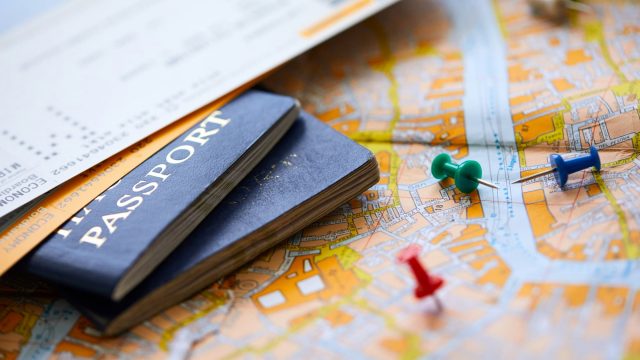If you’re moving abroad or looking to purchase a 2nd home, the process of taking your pets with you may not be something you’ve really thought about in detail. In theory it’s simple but quarantine regulations have made it trickier than you’d first think. Thanks to the Monster Raving Loony Party, pet passports are a real thing and for that we salute them.
Taking Pets Abroad
Why is taking an animal abroad so carefully regulated? In short, rabies.
 Photo by: tashatuvango/Fotolia
Photo by: tashatuvango/Fotolia
What is Rabies?
Responsible for around 60,000 human deaths a year. Affecting the brain and nervous system, rabies is a contagious and fatal viral disease found in mammals. Rabies is nearly always fatal if you don’t receive treatment immediately after infection. The alternative, if you’re travelling to an infected area is to have a vaccination beforehand. Luckily, rabies is not found in British animals with the exception of bats. The Pet Travel Scheme is used to prevent the spread of rabies (& other diseases) into the UK while still allowing pets to travel abroad.
What to do if you’re bitten
If you are bitten by a rabid animal, seek first aid immediately.
- wash the wound thoroughly with soap and hold under running water for 15 minutes
- apply an antiseptic wash or gel to clean the wound
- leave the wound exposed
- go to the nearest hospital or medical centre
Rabies Symptoms
- a high temperature or fever
- an irrational fear of water
- sensitivity to light
- fear of drafts of air
- confusion or aggressive behaviour
How to get a pet passport
Pet passports are available for dogs, cats, and (rather randomly) ferrets and allow you to take a pet cat, dog or ferret between countries without quarantine if you follow the law. In fact when I moved abroad, customs were only worried about ferrets and didn’t acknowledge the cats and dog.
 Photo by: Markus Mainka/Fotolia
Photo by: Markus Mainka/Fotolia
The passport is available through your vet and contains details of ownership, a description of the animal, date of rabies vaccination, date of rabies blood test (if needed), and details of the vet issuing the passport.
You may take 5 animals in one go unless you’re travelling to a show e.g. Crufts.
How much is a pet passport?
This varies from vet to vet. A pet passport typically costs around £150 – £200 per animal although some vets still charge under £100.
 Photo by: Kats/Fotolia
Photo by: Kats/Fotolia
The important thing to remember is timing is everything. Get your dates wrong and little Mittens or Fido won’t be joining you and could be quarantined. So what’s first?
Applying for a Pet Passport – the process
1. Microchip
Your pet must be microchipped before they receive a rabies vaccination or they’ll need to be vaccinated again after they’ve been chipped.
2. Rabies vaccinations
Your pet must be vaccinated against rabies if you wish to take it abroad. If you’re travelling to the EU you must wait 21 days after the vaccination before travelling. In reality this is 22 days as the date of vaccination counts as day zero not day one.
3. Blood tests
In some cases your pet may need to have a blood test 30 days after the vaccination to ensure it’s been effective. This is no longer compulsory.
4. Apply for your pet passport
Once your pet has been microchipped and vaccinated, you may apply for the passport. You will need:
- Your pet’s microchip number
- Vaccination date and vaccine details
- Date when booster vaccination is due. This date is crucial because if missed you will need to have your pet re-vaccinated, and in the case of the UK wait a further 21 days before entry or re-entry into the UK.
5. How long is it valid for?
Pet passports are valid for 3 years. At the end of this date, a rabies booster is required every 3 years and the passport will be updated accordingly. If you miss the deadline by just 1 day, you will have to restart the whole process.
Moving to the USA
Whilst regulations vary from state to state, the procedure for moving to the USA from the UK is much the same as going to Europe. The animal will need to be microchipped, vaccinated, and issued with a passport.
Coming home
If you’re returning to the UK from an EU country, you will need to ensure your pets are microchipped, vaccinated for rabies and wait 21 days before travelling.
Dogs must be treated for tapeworm by a vet (not yourself) no less than 24 hours and no more than 120 hours before travelling. If you’re travelling via ferry or Channel Tunnel, there are vets at the terminals should you be spreading the journey. Vets are also available at international airports throughout Europe and the States.
It is also recommended your pet is treated for ticks before entering the UK due to the risk of tick borne diseases, such as Babesia and Ehlichia which aren’t found in the UK.
Tips
For more information, contact pettravel@ahvla.gsi.gov.uk. If you’ve moved abroad with pets or are in the process of getting a pet passport, let us know your experiences below. If you can tell us how to get the dog to sit quietly in a photo booth without smiling, even better!
In the meantime, don’t forget to sign up to our newsletter below and follow us on Twitter and Facebook for the latest travel tips and news.
Subscribe to our newsletter
Want our blogs emailed direct to you? Sign up below to get updates featuring our blogs and car hire top tips. Receive the best deals on car hire straight to your inbox.






Hi
we take our dog Olly with us to france and spain, lots of dog friendly hotels for the journrey, and lots of dog friendly accomodation to rent, forget hotels and cramped apartments rent a villa with a pool for the same price or cheaper. ,
the pet passport system is so easy to use, do not leave your lovely fluffy ball behind
I have been about 6 times with a dog on the ferry. I cannot stress enough to make sure your passport is correct ,date time etc for the worming tablet when you return or they won’t let you travel. You have been warned !
Well done very useful information, excellent.
However I will add for information that if your pet wears prescription glasses, he/she is allowed to wear them for the passport photo, as long as they are worn while going through customs, oh and they are allowed one bag of hand luggage about the size of a poo bag…. and it must be black!